Thursday
Community Articles, Mountain StatesSangha Retreat: A Rare and Powerful Experience
By Alexandra Milsom
Speaking as a person who slept through her first dathun and mentally redecorated her apartment throughout her second, I understand all too well that the seemingly simple instruction on how to meditate requires both time and the repeated inspiration of other practitioners in order to sink in.
The Sangha Retreat, hosted by Shambhala Mountain Center during the third week of July, was a rare and powerful opportunity to receive those instructions directly from Sakyong Mipham Rinpoche, see the effects of these instructions on one of our community’s greatest practitioners, Ani Pema Chodron, and practice the instructions with the guidance one of our community’s most dedicated young teachers, the Kalapa Acharya Adam Lobel.
“It will take ten years,” said Ani Pema Chodron to a participant who described his difficulties with following the instructions for dropping the habitual storylines created by thoughts while he practiced. It didn’t sound very reassuring at the time, but in retrospect, no one ever said the path to enlightenment would be easy, let alone the deceptively simple-sounding instructions of labeling thoughts and following the breath.
Despite the pain that inevitably arises in peoples’ minds and bodies during intensive practice meditation, the teachers created an environment that felt completely nurturing.
Gentleness and Strength
In an interview after the retreat ended, Kalapa Acharya Adam Lobel explained how the Sakyong laid the foundation of that environment in an initial meeting he held with both Acharya Chodron and himself: “Rinpoche told us that the theme of this retreat was strength manifesting as gentleness, producing non-aggression.”
With this theme in mind, the acharyas, meditation instructors, and staff gave practitioners the opportunity to practice the meditation technique in a setting characterized by its friendliness, kindness, and openness.
Barbara Hirschfeld, Director of the Santa Rosa Shambhala Center, said, “I have been to many programs—large programs with lots of participants. Here, I was struck by the gentleness and by how little people complained. The theme of gentleness really permeated.” Most striking to her was the fact that “enlightened society was really experienced by all. And it was due to the Sakyong, to Pema, and to Acharya Lobel and their teachings.”
Acharya Lobel also was struck by the environment cultivated by the program. In reflecting back on the program, he appeared genuinely pleased to note, “Everyone seemed really genuine and engaged and connected with the practice as well as the global context of Shambhala vision.”
Summer Steeped in Richness
The Sangha Retreat program occurred in the midst of a summer steeped in the richness of the historical introduction of the Scorpion Seal Assembly for advanced-Vajrayana practitioners– teachings that represent a “powerful shift in our inner practices,” in the words of Acharya Lobel.The idea that the Sangha Retreat would be merely “introductory” seemed to place it in sharp contrast with the advanced teachings the Sakyong would present during the rest of the summer.
However, according to Acharya Lobel, the contrast between the two types of programs proved to be less sharp than he would have expected: “Many of us were very excited about this summer because of the opening of the Scorpion Seal Assemblies,” he explained. “But it turns out that the inner shift really has an energetic effect on our whole sangha, and that was very evident here at the Sangha Retreat.”
Role Models for Warriorship
The Sakyong’s talks touched upon matters close to his heart, and no doubt they were influenced by the enormous energy he has put into presenting his father’s Scorpion Seal teachings and by his mandate to help us establish enlightened society by way of the Shambhala teachings.
In his second talk to retreatants, he described the hardships of the teachers and lamas of the previous generation, many of whom “lost their entire families” and suffered untold brutalities as a result of the Chinese invasion of Tibet. In their struggle, the Sakyong explained, and in their continued and unwavering goal of perpetuating the message of compassion and virtue, these teachers embodied the striking power of genuine warriorship when it is infused with gentleness.
His father, Chogyam Trungpa Rinpoche, was an example of the strength of these past teachers. “He walked to India!” the Sakyong exclaimed during his talk. But what the Sakyong really impressed upon the retreatants was not just the extensive physical and emotional hardship endured by this past generation of refugees, but the fact that when they arrived in safety, despite their suffering, their message was still one of compassion, not aggression.
During the question and answer period that followed the Sakyong’s second talk, he assured SMC staff member Bobby Elbers that, indeed, Shambhalians do not need to hide in caves and suffer deprivations in order to accrue the benefits of practice and attain the discipline and wisdom of the lineage holders of the past. He reaffirmed that we will benefit greatly from their example by simply taking this same view of compassion and training ourselves to apply this view wherever we go when we leave the protective container of the shrine tent.
Meditation: A Magnifying Mirror
Acharya Chodron has been practicing long enough to witness at least one generation to grow up and benefit from these teachings on compassion. What’s more, she made it obvious that these teachings work through her repeated and loving references to the instructions she received from her first teacher, Chogyam Trungpa Rinpoche, her gentleness towards the students who voiced the most personal of questions in front of 380 pairs of eyes, and her humorous candor that can only be the result of having made friends with herself despite the unbearable self-scrutiny of years of practice.
Acharya Chodron did not try to make meditation practice out to be something more pleasant than it is, however. “This is actually sounding like a pep-talk for not practicing,” she laughed when talking to the gathered community. She likened sitting for extensive periods of time and following the instructions faithfully to the act of staring at one’s own face in one of those magnifying-mirrors: things might look interesting, but “it doesn’t look pretty,” she warned. It takes a certain amount of bravery and mettle to sit on the cushion, but the act of mustering that honesty and rousing that bravery is the opportunity for participants to practice that very gentleness that the Sakyong had in mind when he set the tone for the week.
On the concluding day of the program, the Sakyong asked the hundreds of people gathered in the tent if they should “do it again.” The answer from the group was a resounding “Yes!”
Tears Accompany a Gesar Song
In that same spirit of celebration, the Sakyong requested that the Sakyong Wangmo, Khandro Tseyang, treat the participants with a song drawn from her family’s lineage-connection to the Epic of Gesar of Ling. For many, it was the very first time they had heard the Sakyong Wangmo sing. “I cried,” said Ian Bascetta of the New York City sangha. “I literally had not cried during the whole retreat, even though I probably should have. And then she started singing and I finally burst.”
Many expressed similar reactions to her performance, proving it to be one of the most moving moments of the week. Her simple act of reminding us of the heroics of Gesar and his fellow warriors became a moment of contextualizing the entire retreat: we are a part of an extensive historical and familial tradition in which the paradoxical contrast between warriorship and gentleness no longer exists; conventional wisdom separates the two, but in skillful combination, these qualities can conquer the obstacles of a dark age.
Power, Relevance, Immediacy
“There was a feeling of the power and relevance and immediacy of the Shamabhala teachings,” said Acharya Lobel, noting that the teachings of that week reached out “way beyond just advanced practitioners towards newer practitioners going forward on the path.”
We can only hope that this Sangha Retreat was the first in what will be a series of opportunities for practitioners to reconnect with the Shambhala teachings and practice establishing enlightened society.
My personal aspiration, I hasten to mention, is that the future dance parties held after the final banquets of these retreats can also live up to the enormously fun precedent set by the participants of this first one. After all, it’s not often that one can dance the night away with a few hundred fellow warriors.
Photo Credits: Brian Spielmann, Barbara Hirschfeld, and Christoph Schoenherr


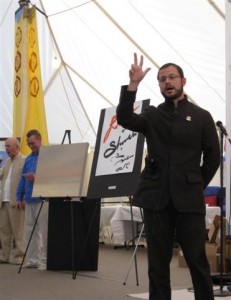

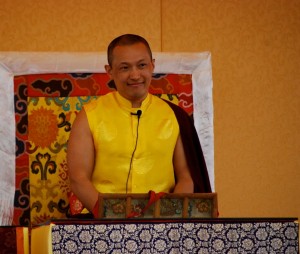
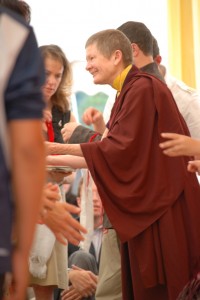
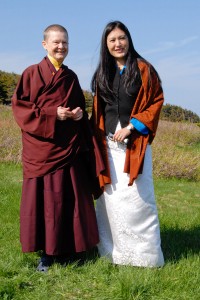
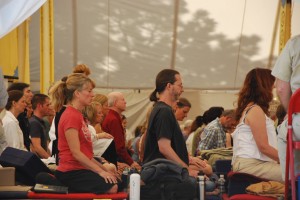
















Aug 31, 2009
Reply
Hey Ms. Milsom,
Great work on the article. It was very well written with that nice touch of Alexandra humor that makes it a good read. Well done, hot stuff.
Lisaleestecklersmith
Aug 13, 2009
Reply
What a wonderful painting of the soul practice of Shambhala – thank you, Alexandra!